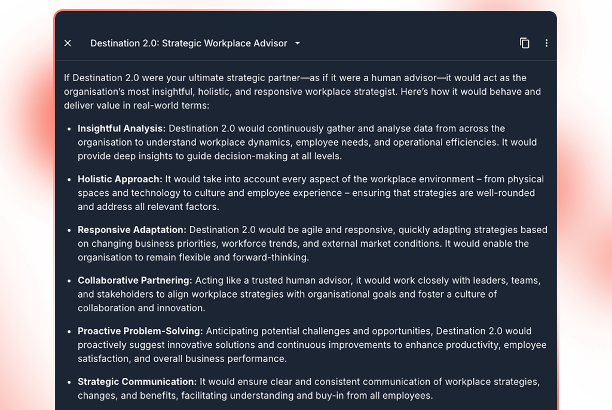Workplace strategy has always relied on data. Headcount forecasts, occupancy studies, employee surveys, and financial models have been the foundation for shaping decisions about space, technology, and policies. The challenge has never been a lack of information but the time and effort required to interpret it, connect the dots, and turn it into actionable insight. Artificial intelligence is changing that equation. When applied thoughtfully, AI can transform workplace strategy from a slow, reactive process into a faster, more adaptive, and more precise discipline.
The rise of AI in workplace strategy is not about replacing human expertise. It is about amplifying it. By processing vast amounts of data quickly, AI can reveal patterns and correlations that are easy to miss in manual analysis. It can combine datasets that were previously siloed — from space utilisation and booking systems to engagement surveys and environmental sensors — to create a more holistic picture of how the workplace is performing and where improvements can be made.
For example, AI can identify underused areas of the office and suggest alternative layouts that better support current work patterns. It can analyse meeting room booking data alongside collaboration tool usage to reveal whether spaces designed for teamwork are being used as intended. It can even forecast future demand for different types of spaces based on historical trends, seasonality, and organisational changes. These insights help leaders make evidence-based decisions that are both timely and relevant.
One of the most compelling uses of AI is in personalising the workplace experience. By understanding the preferences and behaviours of different work personas, AI can recommend desk locations, meeting spaces, or hybrid schedules that maximise both individual productivity and team cohesion. This level of personalisation goes beyond what traditional workplace tools can offer, creating a more engaging and efficient experience for employees.
AI can also play a significant role in linking workplace performance to business outcomes. By integrating data from HR, IT, and operational systems, it can help uncover how changes in the physical environment influence engagement, retention, and performance metrics. This allows workplace leaders to demonstrate the direct value of their strategies in terms that resonate with the C-suite.
However, the use of AI in workplace strategy is not without its challenges. Data quality is critical — inaccurate, incomplete, or biased data will lead to flawed recommendations. Privacy and trust are also essential. Employees must feel confident that their data is being used responsibly and that AI is a tool for enabling better work, not for surveillance. Clear governance, transparent communication, and adherence to ethical guidelines are non-negotiable.
There is also a cultural dimension to integrating AI into workplace strategy. Leaders and managers need to understand how to interpret AI-generated insights and how to act on them. This requires training and support, as well as a willingness to question established practices when the data points in a new direction. AI should be seen as a partner in decision-making, not a final authority.
The organisations that are getting the most from AI in workplace strategy are those that approach it as part of a broader transformation, not as a standalone tool. They combine AI-driven insights with human judgement, balancing the speed and scale of machine analysis with the context and nuance that people bring. They also recognise that AI’s value increases over time, as the system learns from new data and becomes more attuned to the organisation’s specific needs.
In the end, AI is not a magic solution for workplace strategy. But when it is embedded into a clear, people-centred framework, it can dramatically improve the quality and speed of decision-making. It can help leaders see beyond the obvious, anticipate change, and make choices that align space, technology, and culture in a way that keeps the workplace relevant and resilient.
The future of workplace strategy will be shaped by the partnership between human insight and machine intelligence. Those who embrace this partnership now will be better equipped to navigate complexity, respond to uncertainty, and turn data into decisions that make a real difference.
Keen to see this in practice? So head towards www.worktransformers.ai




